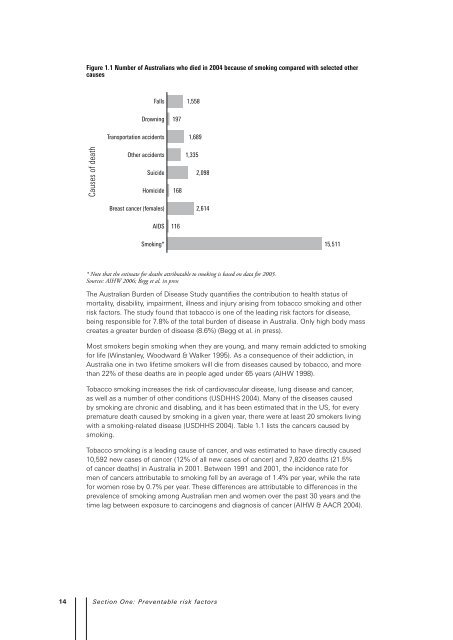National Cancer Prevention Policy - Tobacco Control Supersite
National Cancer Prevention Policy - Tobacco Control Supersite
National Cancer Prevention Policy - Tobacco Control Supersite
You also want an ePaper? Increase the reach of your titles
YUMPU automatically turns print PDFs into web optimized ePapers that Google loves.
Figure 1.1 Number of Australians who died in 2004 because of smoking compared with selected other<br />
causes<br />
Causes of death<br />
Falls<br />
Drowning<br />
Transportation accidents<br />
Other accidents<br />
Suicide<br />
Homicide<br />
Breast cancer (females)<br />
AIDS<br />
Smoking*<br />
197<br />
168<br />
116<br />
1,558<br />
1,689<br />
1,335<br />
2,098<br />
2,614<br />
* Note that the estimate for deaths attributable to smoking is based on data for 2003.<br />
Sources: AIHW 2006; Begg et al. in press<br />
14 Section One: Preventable risk factors<br />
15,511<br />
The Australian Burden of Disease Study quantifies the contribution to health status of<br />
mortality, disability, impairment, illness and injury arising from tobacco smoking and other<br />
risk factors. The study found that tobacco is one of the leading risk factors for disease,<br />
being responsible for 7.8% of the total burden of disease in Australia. Only high body mass<br />
creates a greater burden of disease (8.6%) (Begg et al. in press).<br />
Most smokers begin smoking when they are young, and many remain addicted to smoking<br />
for life (Winstanley, Woodward & Walker 1995). As a consequence of their addiction, in<br />
Australia one in two lifetime smokers will die from diseases caused by tobacco, and more<br />
than 22% of these deaths are in people aged under 65 years (AIHW 1998).<br />
<strong>Tobacco</strong> smoking increases the risk of cardiovascular disease, lung disease and cancer,<br />
as well as a number of other conditions (USDHHS 2004). Many of the diseases caused<br />
by smoking are chronic and disabling, and it has been estimated that in the US, for every<br />
premature death caused by smoking in a given year, there were at least 20 smokers living<br />
with a smoking-related disease (USDHHS 2004). Table 1.1 lists the cancers caused by<br />
smoking.<br />
<strong>Tobacco</strong> smoking is a leading cause of cancer, and was estimated to have directly caused<br />
10,592 new cases of cancer (12% of all new cases of cancer) and 7,820 deaths (21.5%<br />
of cancer deaths) in Australia in 2001. Between 1991 and 2001, the incidence rate for<br />
men of cancers attributable to smoking fell by an average of 1.4% per year, while the rate<br />
for women rose by 0.7% per year. These differences are attributable to differences in the<br />
prevalence of smoking among Australian men and women over the past 30 years and the<br />
time lag between exposure to carcinogens and diagnosis of cancer (AIHW & AACR 2004).




